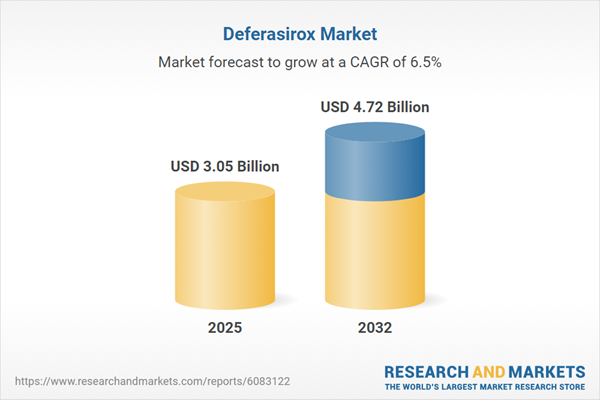Speak directly to the analyst to clarify any post sales queries you may have.
The global deferasirox market is entering a dynamic phase as advancements in iron chelation therapy intersect with evolving regulatory, clinical, and operational demands. Senior decision-makers today require clear market intelligence to identify growth avenues and navigate uncertainty.
Market Snapshot: Deferasirox Market Growth & Outlook
The deferasirox market is positioned for sustained growth, projected to increase from USD 2.86 billion in 2024 to USD 3.05 billion in 2025, at a compound annual growth rate (CAGR) of 6.45%. By 2032, the market is expected to reach USD 4.72 billion. This upward trajectory reflects robust clinical adoption driven by heightened awareness of oral iron chelation options, ongoing improvements in regulatory environments, and widening applications across major iron overload disorders—including in both established and emerging healthcare systems. Broader demographic uptake and access to innovative formulations are building consistent demand and expanding the reach of deferasirox globally.
Scope & Segmentation: Strategic Deferasirox Market Analysis
This report offers an actionable assessment for executive and operational planning, detailing the principal segments and their relevance:
- Indication: Beta thalassemia, myelodysplastic syndromes, and sickle cell disease are the main therapy targets, each representing distinct clinical challenges and patient management pathways.
- Formulation: Film coated tablets and oral granules for suspension deliver varied delivery profiles tailored to patient preferences, dosing convenience, and therapy adherence.
- Patient Age Group: Treatment requirements diverge significantly across adult, geriatric, and pediatric sub-groups, impacting protocol choices, adherence strategies, and patient outcomes.
- Therapy Duration: Patterns of long term and short term therapy guide decisions on treatment planning, monitoring, and resource allocation for healthcare providers.
- Distribution Channel: Offline pharmacies, manufacturer-run online platforms, and third-party e-commerce marketplaces determine market penetration and mitigate risks to supply chain reliability.
- End User: Home healthcare, government hospitals, private hospitals, and specialty clinics form the primary points of access, influencing care continuity and delivery costs.
- Region: Americas (including the United States, Canada, and Latin American markets), Europe, Middle East & Africa, and Asia-Pacific span a diverse regulatory and operational landscape, requiring region-specific compliance, access, and commercialization tactics.
- Companies Covered: Leading manufacturers such as Novartis AG, Teva Pharmaceutical Industries Limited, Sandoz International GmbH, Viatris Inc., Sun Pharmaceutical Industries Limited, Cipla Limited, Dr. Reddy’s Laboratories Limited, Aurobindo Pharma Limited, Lupin Limited, and Glenmark Pharmaceuticals Limited ensure a competitive market with varied manufacturing footprints and supply capabilities.
Key Takeaways for Senior Leaders
- Deferasirox’s oral delivery method has improved patient experience and adherence compared to injectable treatments, supporting ongoing patient engagement across therapy cycles.
- Global harmonization of regulatory policies is expediting development timelines and facilitating broader access to innovative iron chelation solutions with demonstrated therapeutic value.
- Distinct age group needs call for adaptive dosing and targeted patient support programs, making flexible solutions and education crucial to maximizing therapy benefits.
- Digital health solutions for adherence monitoring and remote clinical evaluation enable data-driven intervention, offering new channels to personalize care within iron overload management.
- Geographical variation in reimbursement policies, distribution infrastructure, and compliance requirements underscores the necessity of tailored go-to-market and expansion models.
- Collaborative initiatives involving pharmaceutical manufacturers, health technology firms, and research networks are driving new product development and accelerating the adoption of advanced formulations in clinical practice.
Tariff Impact: Navigating 2025 US Trade Tariffs
The 2025 US tariffs introduce escalating cost pressures for deferasirox manufacturers, primarily in sourcing active ingredients and raw materials. To counter these challenges, market leaders are diversifying procurement sources, scaling up localized and joint manufacturing, and securing supply continuity through value-based contracting and new technology partnerships. These strategies are designed to protect profit margins and fortify supply resilience, supporting steady product availability and market stability.
Methodology & Data Sources
This analysis draws upon peer-reviewed journal data, leading regulatory sources, and real-world clinical outcomes. Findings have been validated through expert consultations with senior professionals in hematology, pharmacology, and market access, ensuring actionable and robust market insight.
Why This Report Matters
- Offers senior teams a comprehensive, executive-level perspective on deferasirox market dynamics, enabling confident strategic and operational planning within a shifting therapy landscape.
- Informs priorities for investment, partnership, and commercialization by illuminating the most influential market segments, technology advances, and expansion opportunities.
- Provides early identification of risks linked to regulatory, trade, or supply chain changes, supporting proactive management and organizational resilience.
Conclusion
The deferasirox market is advancing through strategic innovation, regulatory adaptation, and a growing emphasis on meeting patient and system needs. Insight-driven leadership remains essential to capture emerging opportunities and guide successful organizational growth in iron chelation therapy.
Table of Contents
3. Executive Summary
4. Market Overview
7. Cumulative Impact of Artificial Intelligence 2025
Companies Mentioned
The companies profiled in this Deferasirox market report include:- Novartis AG
- Teva Pharmaceutical Industries Limited
- Sandoz International GmbH
- Viatris Inc.
- Sun Pharmaceutical Industries Limited
- Cipla Limited
- Dr. Reddy’s Laboratories Limited
- Aurobindo Pharma Limited
- Lupin Limited
- Glenmark Pharmaceuticals Limited
Table Information
| Report Attribute | Details |
|---|---|
| No. of Pages | 188 |
| Published | October 2025 |
| Forecast Period | 2025 - 2032 |
| Estimated Market Value ( USD | $ 3.05 Billion |
| Forecasted Market Value ( USD | $ 4.72 Billion |
| Compound Annual Growth Rate | 6.4% |
| Regions Covered | Global |
| No. of Companies Mentioned | 11 |









